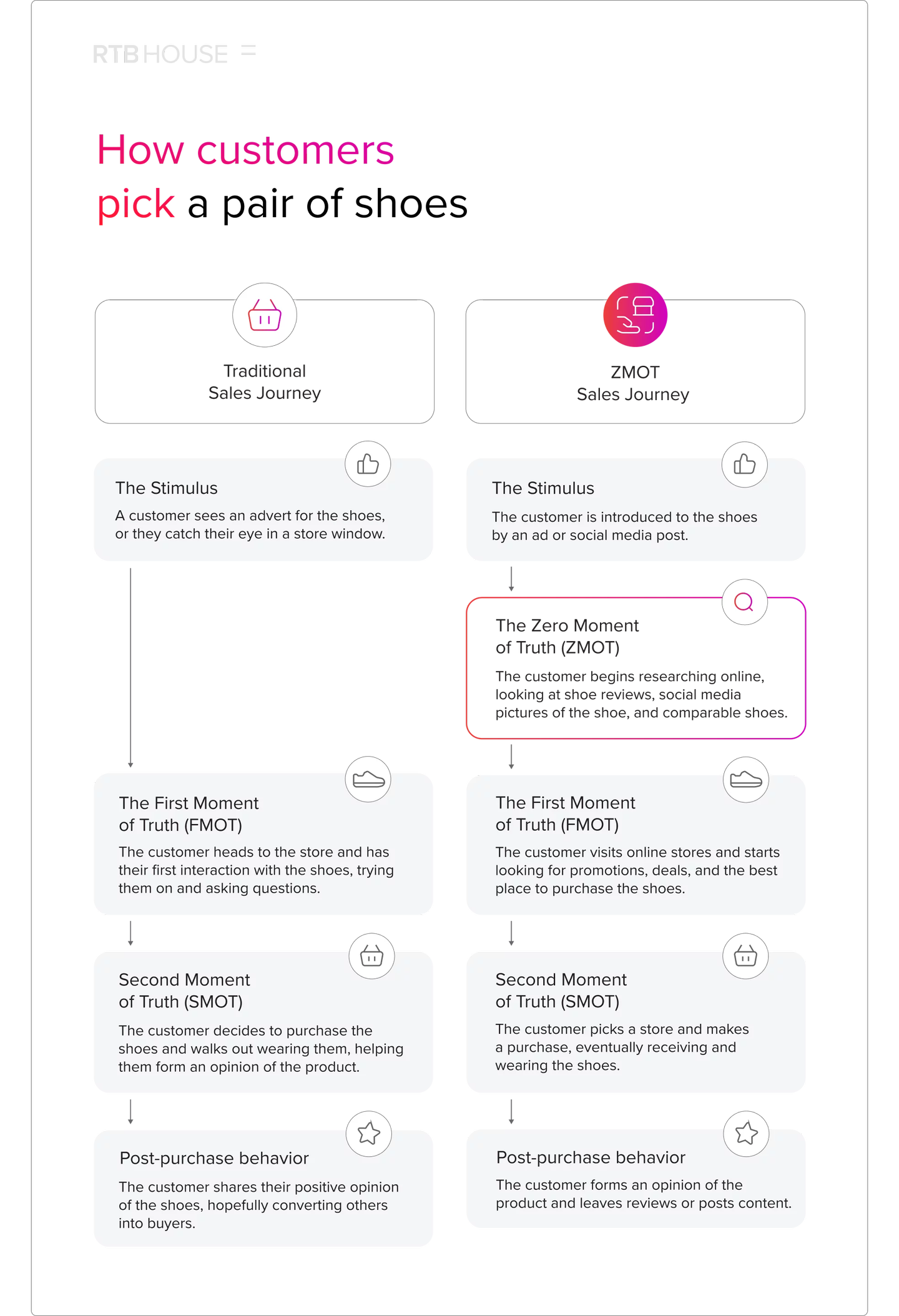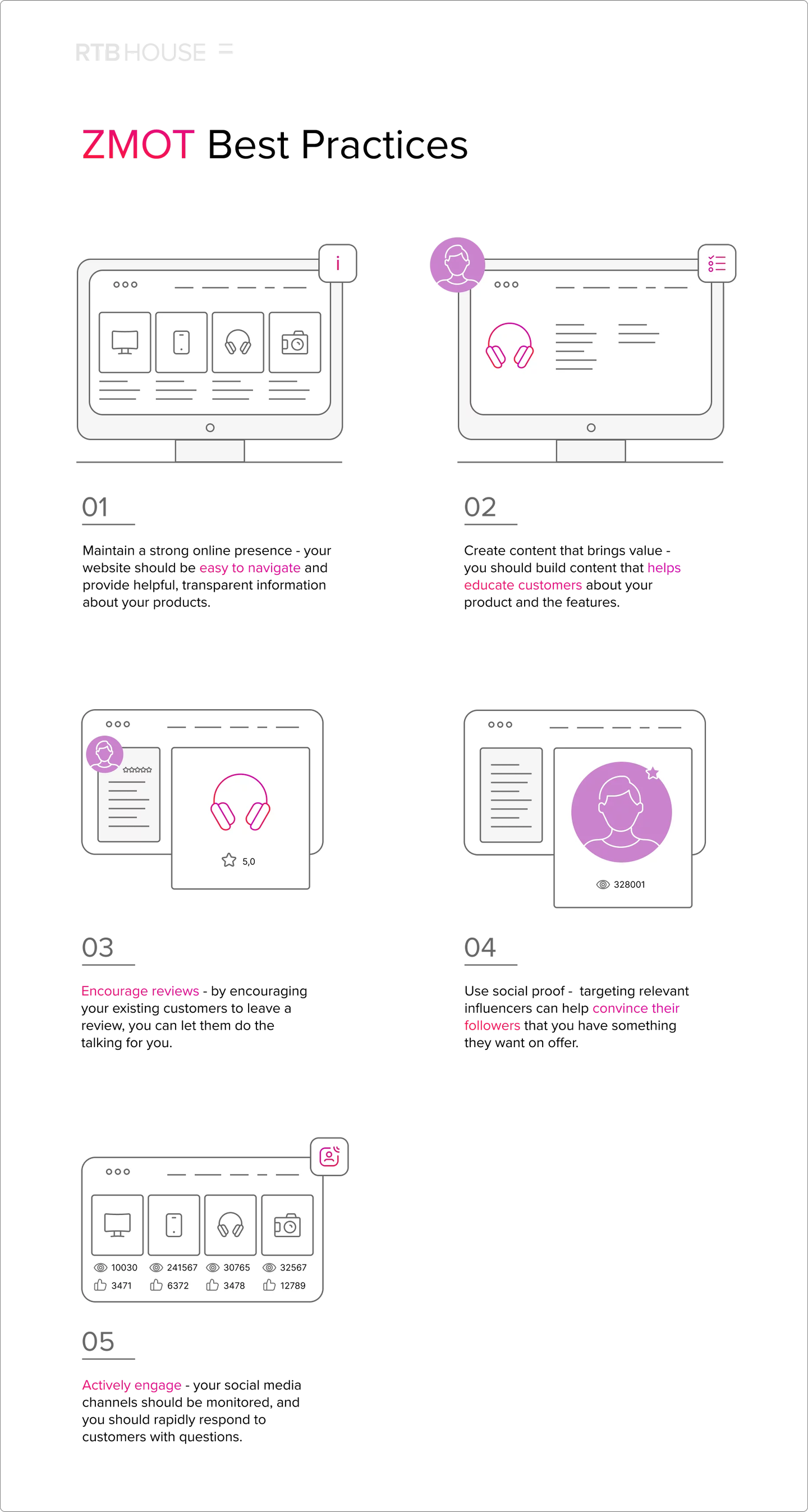In an environment where customers have countless ways to engage with a product before purchasing, we need to rethink how we approach marketing activities. To achieve this, marketers often use a concept coined by Google called the “Zero Moment of Truth” (ZMOT). This represents the moment when customers engage with a product or service online before they make any commitments to purchase it.
Making the most of ZMOT is the key to a successful marketing strategy, particularly regarding retargeting, and this article will help you understand how to do just that.
What is the Zero Moment of Truth?
The Zero Moment of Truth (ZMOT) is a concept coined by Google to describe the critical moment in the consumer decision-making process that occurs before a purchase is made. In the traditional buyer decision-making process, there are three steps:
- The stimulus—this is the moment when a buyer is first introduced to your brand, for example, through an advert.
- The first moment of truth (FMOT) is when a buyer physically interacts with your product, either on a store shelf or as part of a physical demonstration; it is when a customer makes a split-second decision to either make a purchase or not.
- The second moment of truth (SMOT)—occurs when a customer actually uses their product for the first time. This is crucial to obtaining return customers, positive reviews, and building a strong brand reputation.
Unlike this traditional model, where a customer’s purchasing decisions are influenced at the store (the First Moment of Truth) or through the use of the product (the Second Moment of Truth), ZMOT happens online when customers search for information about a product or service.

ZMOT can encompass everything from reading reviews, searching for competitor products to compare prices, or watching video reviews or demonstrations. During the ZMOT, customers are highly engaged and form crucial opinions that will influence their future purchasing decisions. In essence, the Zero Moment of Truth is recognizing that customers perform their own research on a product before making a purchase and have the time and resources to do so effectively.
Why is the ZMOT so important?
It comes down to intent. When a user is simply shown a product on social media, only around 1% will convert into paying customers. However, when they’re actively searching for a product, this jumps up to 3%. This is because the customer is actively seeking out more information about your product and is likely at their most engaged during this research process.
Importantly, ZMOT is also the moment where customers are looking for a benchmark against which to value other products. If they decide that there is not enough information available about a particular product, they will probably discard it entirely rather than ask you to provide it. Indeed, barriers to information will frustrate and put off potential buyers, and ZMOT is focused on ensuring that customers have everything they need to make an informed decision.
What channels do users access during the ZMOT?
81% of customers conduct research prior to making a purchase. This research takes a variety of forms, but 65% are interested in product comparison sites, and 93% will read reviews, either on an e-commerce site itself or on a specialized website.
This usually takes place on the open web, and it is a brilliant opportunity for brands to connect with potential customers at a moment of high engagement. It also means that brands need to find ways to connect with users to research their product or similar products.
ZMOT best practices
In order to make the most of ZMOT, there are some simple best practices that companies can follow:
- Maintain a strong online presence—your website should be easy to navigate and provide helpful, transparent information about your products to make it easy for potential customers to gather the information they need. You should also use a strong SEO strategy to make sure customers can find you.
- Create content that brings value—Rather than taking a scattergun approach, you should build content that helps educate customers about your product and the features that will make their lives better.
- Encourage reviews—customers rely heavily on reviews when making a decision, and they trust other customers the most. By encouraging your existing customers to leave a review, you can let them do the talking for you.
- Use social proof—social media is a powerful tool, and targeting influencers who have some reason to connect with your brand can help convince their followers that you have something they want on offer.
- Actively engage—your social media channels should be monitored, and you should rapidly respond to customers with questions. This shows that you care and helps you build trust over time.
When engaging, you should remember that ZMOT is a long-tail process, so you need to ensure that you are making contact with them throughout the process across various channels. Customers may drop in and out of the process during ZMOT, but constantly engaging with them positively is key. Retargeting is a useful tool for doing just that.

Retargeting is a powerful tool to connect with users at the ZMOT
Retargeting is a way to reconnect with users who have shown interest in your products. It works by interpreting data to identify customers who have shown interest in your site. Sophisticated retargeting solutions can further determine what content to display to a user based on their behavior.
This approach is particularly useful at the Zero Moment of Truth. Users are highly engaged and are already actively searching for your products. If you can show them content that showcases the best of your product, this can cultivate a positive journey for the customer, increasing the likelihood of conversion. It will also enable you to prevent competitors from attempting to poach customers out from under you with their own retargeting efforts!
To understand how this works, let’s take a look at three short examples:
Keeping a customer engaged during the research phase
Once a customer has encountered your product, it is essential to keep them engaged. Once they leave your website, you can use retargeting to constantly remind customers about the product, or similar products, that they have already seen on your website.
This approach enables you to keep constant communication with the customer and help guide them towards a purchase that they will love by providing them with relevant information. Particularly sophisticated retargeting methods can even pinpoint what elements of a product a customer is likely to be interested in, for example, energy efficiency, and highlight those in compelling creatives.
Alerting customers about a new promotion or offer in your store
Customers are always on the lookout for deals. Sometimes, they might leave your store without a purchase simply because you weren’t running a promotion. If you know that someone was considering a product, retargeting is a great way to alert them about a sale.
This might be enough to tempt them over to your store and grab you a conversion that you would have missed otherwise.
Upselling a customer on useful accessories
An often overlooked aspect of retargeting is the ability to upsell customers on product bundles. The ZMOT is when customers are most open and curious about a product, and this is an opportunity to sell them other things that will enhance their overall experience.
For example, users who are purchasing swimwear might also be interested in purchasing snorkeling gear, particularly if the data shows that they are planning a beach holiday. Retargeting at the ZMOT can let you show users complementary products that might increase their overall purchase value.
Retargeting is a powerful tool to connect with users at the ZMOT
Retargeting is a way to reconnect with users who have shown interest in your products. It works by interpreting data to identify customers who have shown interest in your site. Sophisticated retargeting solutions can further determine what content to display to a user based on their behavior.
This approach is particularly useful at the Zero Moment of Truth. Users are highly engaged and are already actively searching for your products. If you can show them content that showcases the best of your product, this can cultivate a positive journey for the customer, increasing the likelihood of conversion. It will also enable you to prevent competitors from attempting to poach customers out from under you with their own retargeting efforts!
To understand how this works, let’s take a look at three short examples:
Keeping a customer engaged during the research phase
Once a customer has encountered your product, it is essential to keep them engaged. Once they leave your website, you can use retargeting to constantly remind customers about the product, or similar products, that they have already seen on your website.
This approach enables you to keep constant communication with the customer and help guide them towards a purchase that they will love by providing them with relevant information. Particularly sophisticated retargeting methods can even pinpoint what elements of a product a customer is likely to be interested in, for example, energy efficiency, and highlight those in compelling creatives.
Alerting customers about a new promotion or offer in your store
Customers are always on the lookout for deals. Sometimes, they might leave your store without a purchase simply because you weren’t running a promotion. If you know that someone was considering a product, retargeting is a great way to alert them about a sale.
This might be enough to tempt them over to your store and grab you a conversion that you would have missed otherwise.
Upselling a customer on useful accessories
An often overlooked aspect of retargeting is the ability to upsell customers on product bundles. The ZMOT is when customers are most open and curious about a product, and this is an opportunity to sell them other things that will enhance their overall experience.
For example, users who are purchasing swimwear might also be interested in purchasing snorkeling gear, particularly if the data shows that they are planning a beach holiday. Retargeting at the ZMOT can let you show users complementary products that might increase their overall purchase value.
/assets/images/11840399/original/37f1aaf9-02e1-4237-9b94-1a402a256318?1674025461)


/assets/images/11840399/original/37f1aaf9-02e1-4237-9b94-1a402a256318?1674025461)
